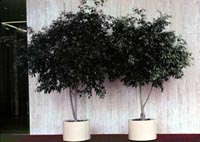Resource Library
Plant of the Week: Weeping Fig (Ficus)
The University of Arkansas System Division of Agriculture does not promote, support or recommend plants featured in "Plant of the Week." Please consult your local Extension office for plants suitable for your region.
Plant of the Week
Weeping Fig
Latin: Ficus benjamina

I have a love-hate relationship with this tree.
I love its graceful, weeping form with a mixture of 3-inch long, shiny, dark green
and light green leaves. I hate its tendency to be finicky and the fact that it seems
to always be recovering from one ailment or anticipating its next.
Like so many things in life, it has its good points and its bad ones.
The weeping fig is a relative newcomer to the houseplant world, mainly arriving in
large numbers with the construction of shopping malls in the 1970's. At that time
the foliage plant craze was sweeping America and the demand for a "normal" looking
shade tree-shaped plant was much in demand. The weeping fig, known to most of the
70's vintage houseplant enthusiasts as "ficus," was in the right place at the right
time to sweep across the U.S. and move into most of our homes.
What are the origins of the weeping fig tree?
This fig is native of southeastern Asia and the Malayan peninsula and is a member
of the mulberry family. It is a 30- to 40-foot evergreen tree in its homeland, but
its size in the average home is more manageable and pretty much determined by how
big its pot is and how much light it has. Usually, the trees are under 10 feet tall.
The weeping fig is usually grown as a single stem tree, often with dangling aerial
roots that strive to reach the ground like its cousin the banyan of India. However,
some creative growers or frustrated hair stylists -- I’ve never been sure which --
discovered it was possible to braid the stems of the weeping fig. Braiding tree stems
is an ingenious idea, especially considering it allows the producer to use poor quality
rooted ficus cuttings that would otherwise be destined for an early end on the compost
heap. Of course it wasn’t long before people were entwining golf balls, rocks, beanie
babies and all manner of memorabilia into the stems.
While these braided tree trunks may not be preferred by the horticultural establishment,
the trees don’t seem to mind one bit. The stems grow together and eventually behave
as one trunk.
How do I care for my weeping fig?
Weeping figs do best when there is bright light -- usually 250- to 400-foot candles.
They will tolerate lower levels, down to as low as 40 ft-c, but they drop a lot of
leaves at the lower light levels and tend to have leaves toward the ends of the branches.
Because they have the potential of getting big, they should be repotted only when
the tree begins to seriously suffer from being root bound. Then, only a slightly larger
pot should be used to keep the tree growing but to avoid giving it too much fresh
soil so it can make a break for it. Weeping figs should receive normal watering with
fertilizer applied periodically when the tree is making some new growth.
Common Problems
The main problems with weeping figs are leaf drop, scale and a twig blight. Leaf drop
is most likely to occur during the fall and spring at the change of seasons and is
a part of the normal cycle of growth for the plant. However, ficus plants also tend
to drop leaves rather heavily when moved from one growing environment to another.
Scale insects cling closely to the stem of the plant and are often difficult to see.
The first sign often noted is that your foot sticks to the carpet under the tree.
This honeydew deposit is usually a clear indication of scale problems.
The twig blight results in stem dieback which is caused by a fungus disease that
is usually more serious under low light levels. It is best treated by pruning out
the infected areas and giving the plant better growing conditions.
By: Gerald Klingaman, retired
Extension Horticulturist - Ornamentals
Extension News - July 2, 1999
The University of Arkansas System Division of Agriculture does not maintain lists of retail outlets where these plants can be purchased. Please check your local nursery or other retail outlets to ask about the availability of these plants for your growing area.